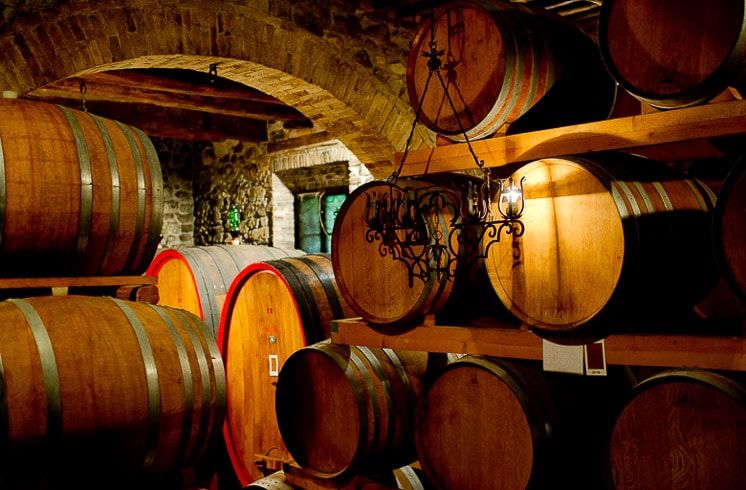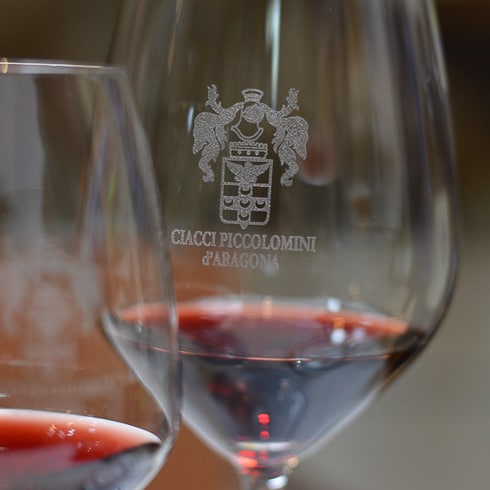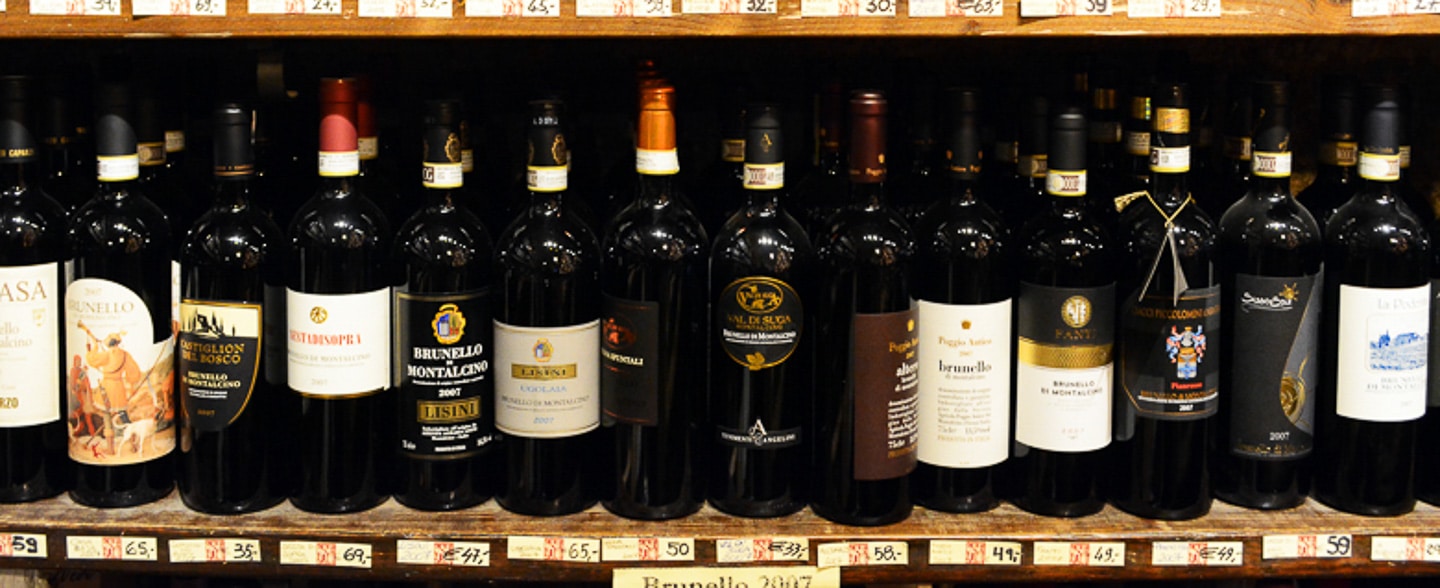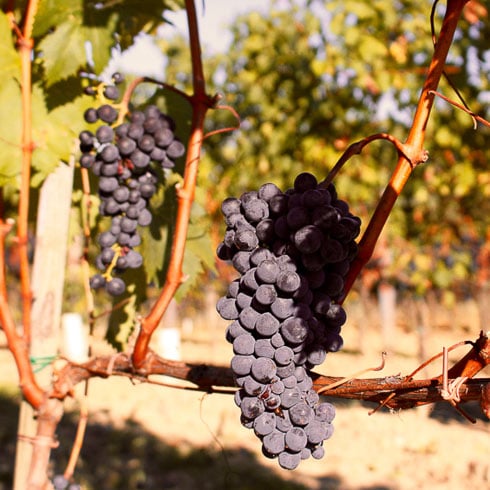It’s a climb I know intimately, having led bike tour groups up it for 10 years: the initial easy grades with an unnerving view of the town way above, the tougher section that picks up right after Casanova dei Neri winery, and the final kilometer up into town (with a tough 200 meters right at the end). But today, biking takes a back seat. It’s Montalcino’s annual Benvenuto Brunello event, which celebrates the release of the latest vintage. This year, after aging for 50 months, the wines of the 2012 harvest are finally ready to taste.
Benvenuto Brunello is crowded with lots of tuxedo-wearing wine connoisseurs scribbling tasting notes as they move from producer to producer, sipping and swirling Rossos, Brunellos, and Riservas. And though this isn’t my kind of event, I start tasting and engaging the staff behind each bottle. But my questions run deeper than most and this is proving to be a less-than-ideal forum for my curiosity.


What I really want to ask each producer is, “Why you? What makes your Brunello better than your neighbors’?” In the Brunello region—where 210 different producers are crammed into a 10-by-10-mile square surrounding the town of Montalcino—this seems like the question. Every producer has a raison d’etre that sets them apart: new barrels, old barrels, big barrels, small barrels, rows planted across the hills, rows planted down the hills, cutting the grass in the vineyards, or letting it grow. It’s like the butter-side-up/butter-side-down controversy at the heart of Dr. Seuss’ Butter Battle Book. Here at Benvenuto Brunello, there are organic vineyards, biodynamic wineries—even one that plays Mozart in the vineyards to produce better grapes.


Still, no amount of comparison can stir up even the smallest hint of jealousy or controversy. There is a kind of code among Brunello vintners that forbids speaking ill of their fellow producers. It makes sense when you consider that, greater than the success of individual producers, Brunello is a brand in itself, and a rising tide lifts all ships. Even the producer selling his bottles for €15 to €20 counts his blessings to be within the magical borders of Montalcino rather than outside the region, where strict DOCG designations would prohibit him from using the Brunello name (and thus commanding only half the price).
And the market is only getting better. Since the Brunello Consortium limits the number of bottles produced each year based on the acreage of each vineyard, the Brunello supply enjoys a relatively stable supply even while global demand continues to grow. The pricing, however, is all over the place. For example, Biondi Santi, the venerable flagship Brunello winery, sells its 2011 for $185, while its lesser-known neighbors Croce di Mezzo and Fornacella retail the same vintage for $54 and $26, respectively.

What seems like an opportunity for arbitrage—buying cheaper Brunellos from the neighbors of famous producers—is actually a lot more complicated. Simply looking at a map of where the famous producers are stationed won’t show that some have vineyards scattered throughout the Brunello zone. Casanova dei Neri, for example, took the world by storm with their 2001 Cerretalto Brunello when it scored a perfect 100 in Wine Spectator. But you won’t find the same quality in the vineyards surrounding its winery—their Cerretalto cru is located on a separate hill entirely.
But let’s assume for argument’s sake that most wineries are located next to their vineyards. Can geography be a predictor of quality across the Brunello zone? I’ve plotted out where the 18 most expensive Brunello wines come from (as listed on Wine-Searcher), represented by a blue star. The red dots show the location of all Brunello wineries to give a better sense of the density of producers in each area.


The plotted points are pretty well scattered, but take into account the density of top-tier wineries in the two areas circled above. I’ve named the smaller yellow region the “Gaja-Soldera Golden Circle,” after two legendary names in viticulture. Gaja got his start in his hometown of Barbaresco in Piedmont, but showed a Midas touch in his early bet on the Bolgheri region, now a producer of some of Italy’s top wines. His choice to purchase this particular piece of Brunello vineyard in 1994 is a testament to the terrain. Gaja’s neighbor, Soldera, is also frequently found near the top of the ratings and price list for Brunellos. The fact that this pair of esteemed wineries are only a stone’s throw apart is no coincidence. But with prices starting at $100 and only rising from there, why not try some Brunellos from the same “Golden Circle” terroir? Fattoi, Máté, and Caprili are all highly rated yet priced closer to $50 per bottle.
The larger, green circle follows a dirt road stretching from the scenic village of Castelnuovo to Sant’Angelo in Colle. Here, too, there is a similar concentration of top producers and their lesser-known neighbors, listed above.


Armed with my analysis, I begin to ask Benvenuto Brunello producers a more pointed question: “If you could buy a vineyard anywhere in the Montalcino area, where would you buy?” Finally, I think, this will crack the jealousies surely lurking beneath the surface. But no. The responses are vague and philosophical: “It depends on the vintage; some years it’s better to be in one place and some years it’s better in another.” I throw in the towel, return my rented wine glass, and drive out of town to see my friend Paolo, owner of Ciacci Piccolomini and passionate cyclist.

Paolo’s vineyards are within the mythical green circle just outside Castelnuovo, and he tells me I’m not the first person to broach the topic of special regions within the Brunello zone. When I press him on being in Brunello heaven, I finally get as close to an acknowledgment as I ever will. He modestly and diplomatically admits that “the Southeast corner of Montalcino is particularly well-suited to grape-growing in that it enjoys a great south-facing exposition and is favored by an exceptional microclimate (marine winds, proximity to the extinct volcano Mt. Amiata and Orcia River).”
So that’s it then. This is as much dust as I’ll be able to stir up, a faint admission that certain superior terroirs exist within the Brunello region. I smile as I drive back down the hill from Montalcino, feeling that I’ve finally peeled back a layer—albeit thin—of impermeable Brunello politics.
Do your own research on Brunello and find out which Montalcino wineries DuVine guide Tom liked the best on our Tuscany Bike Tour.


